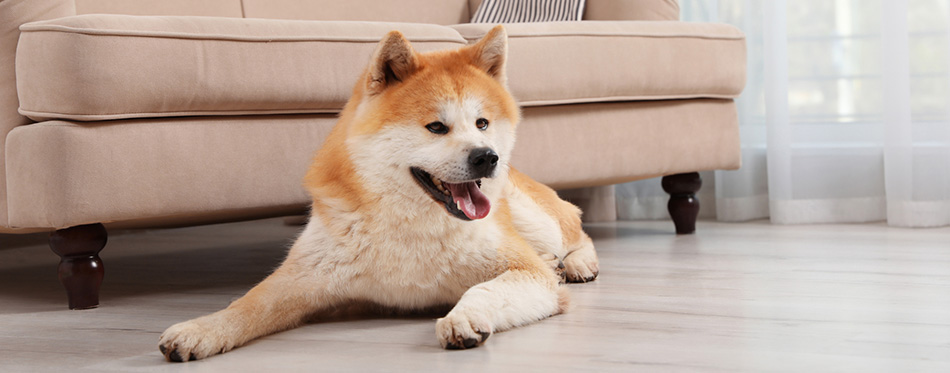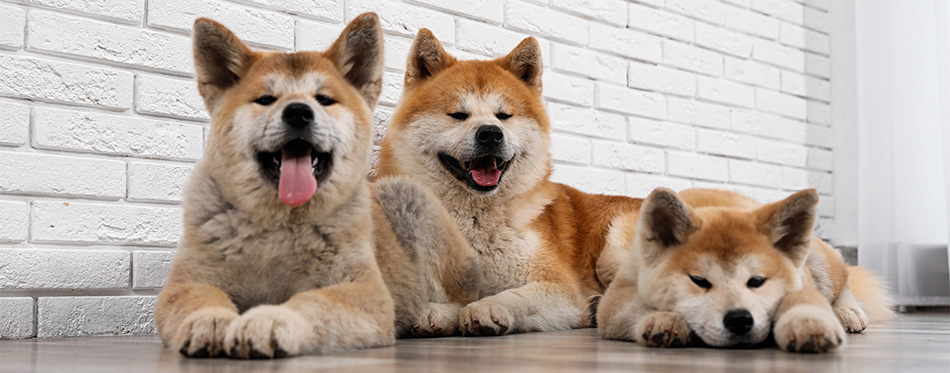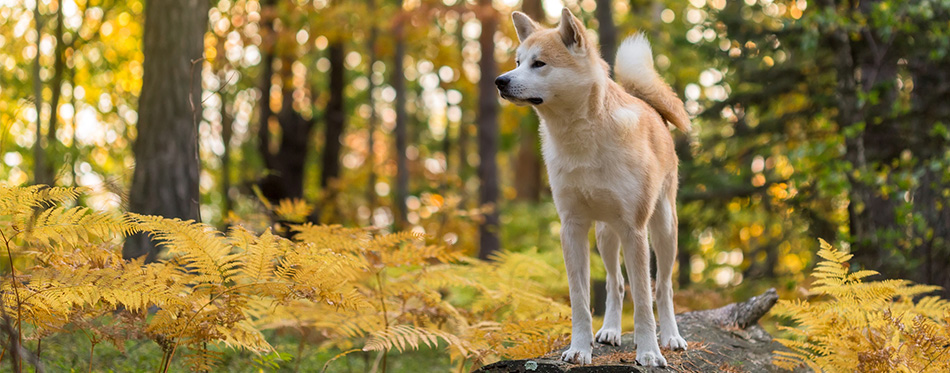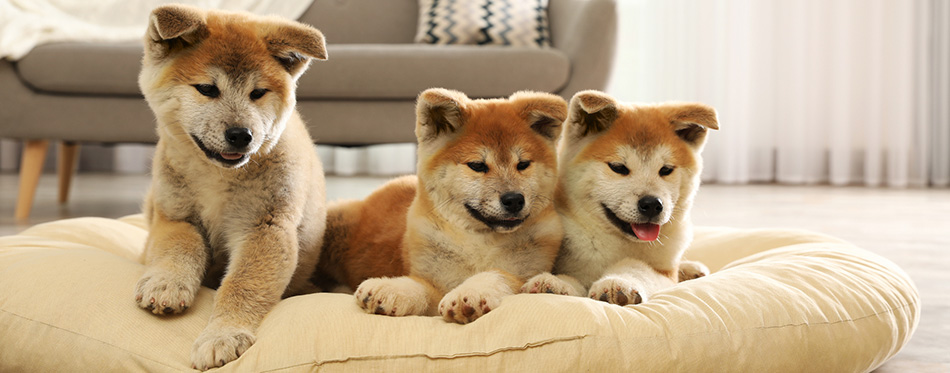Very few dog breeds can be as loyal and faithful as the Akita Inu. The pride of the Japanese people, this dog is known for its fierce loyalty, devotion, and affection for its human family. It is a defender and a protector with a strong sense of independence. These are characteristics that can make the Akita quite challenging for newbie dog owners.

History of the Akita Dog
The Akita Inu is one of the world’s oldest or most ancient dog breeds. While the historical accuracy of this claim is disputable, fanciers believe that the Akita’s ancestors have been around for more than 6,000 years.
The earliest descriptions of these Akita ancestors come from early-17th century documents in the Akita Prefecture in Japan’s Honshu Island. They were known as the Matagi dogs, named after the winter hunters of the Shirakami-Sanchi forested areas. These ancient peoples hunted bears, moose, elk, wild boar, and deer. They used Akita Matagi dogs in their hunt because of the dog’s unflinching tenacity, courage, and sheer strength. These dogs are the direct ancestors of the modern-day Akita Inu.
By the middle of the 19th century, the Matagis began crossing the Akita with Mastiffs and Tosas. These are large breeds of dog that are well-known for their bull-baiting and bear-fighting skills. This also gave the modern Akita its characteristic heft.
Hirokichi Saito conducted a study in the late 1920s and found out that there were only 30 purebred Akita Inus remaining in Japan. One of these “last” few Akita purebreds was Hachiko.
In 1934, the Japanese created the first Akita Inu breed standards. This came right after the Japanese government declared the Akita Inu as one of Japan’s Natural Monuments.
American author Helen Keller brought an Akita Inu to the US upon her return from a trip to Japan in 1937. A certain Mr. Ogasawara presented the dog to Keller and named it Kamikaze-go. Unfortunately, this Akita Inu did not survive long, dying of distemper a month after arriving in the US. Kamikaze-go was only 7.5 months old at the time of its death.
Mr. Ogasawara arranged for the shipping of Kamikaze-go’s younger sibling, Kenzan-go, to be given to Helen Keller as a replacement. Kenzan-go lived for almost a decade, dying in the mid-1940s.
The Second World War was also not very kind to the breed. The Japanese Imperial Army only sought German Shepherds for guard duties. Any other breed of dog was exterminated and used to feed a starving population. Die-hard fans of the Japanese Akita sought to save the breed from extinction. They gave their dogs names that sounded German. They also hid these dogs in very remote villages, allowing the dogs to breed back to their Matagi dog ancestors. Some were cross-bred with German Shepherds, producing larger Akitas than the original Akita Inu. During the war, there were only 20 purebred Akitas left.
Morie Sawatashi, a devout Akita fan, sought to bring back the Akita Inu to its original roots. Fanciers of the breed gathered and exhibited their Akitas in local dog shows. Because of these activities, the dog was able to grow in number, allowing the breed to strengthen its original breed characteristics.
Many of the US servicemen who have seen the “new” Akita brought some of these dogs back to the United States during post-war Japanese occupation and reconstruction. Americans preferred the Akita Inu-German Shepherd mix because it was larger and heavier boned. It also had a bear-like head, instead of the foxlike head of the original breed.
In 1955, the American Kennel Club recognized the Akita as a breed. However, the organization classified it in its Miscellaneous Group. It was only in 1972 when the AKC recognized it as a Working Dog. When the AKC disallowed the importation of additional Japanese Akita dogs in 1974, it paved the way for the divergence between the American Akita and the Akita Inu. This divergence is what we see today.

Quick Facts About the Akita
Never underestimate the size of the Akita. It is small but it has the heart of a noble champion. After all, this is a breed that has existed for at least 6,000 years. Learn more about this lovely dog breed and find out if you’ve got what it takes to become its next pet parent.
- It is a spitz type of dog
The Akita Inu belongs to a group of dogs known as Spitzes. They have striking physical similarities, including their coat, muzzle, ears, and tail. The coat is thick, allowing them to thrive in the harsh climates of the northern hemisphere. They have an undercoat that’s waterproof with insulating properties. The outer coat is dense, further enhancing their ability to survive in near-freezing conditions.
Spitzes have small, pointed ears. The ears help reduce the risk of developing frostbite. Many Spitzes also retain the facial features of the Gray Wolf. The Akita has this wolf-like look to it but with a stockier build. They also have the wolf’s independence and suspiciousness, which can escalate into aggression if they are unsure of another person or other dogs.
- Dignified like the legendary samurai
Looking at the Japanese Akita, it has a very dignified stance. Fanciers say it has the look of Japan’s legendary Samurai. All limbs should be parallel to each other. They should never be knock-kneed or bowlegged. It is also athletic, with well-developed muscles visible on its body and legs.
The American Akita has a bear-like head while the Japanese Akita has a foxlike head. It comes with small, deep-set dark eyes. They take a triangular shape, instead of the usual rounded or almond-shaped eyes of other canine breeds. Their feet are well-knuckled, resembling those of a cat. The Akita’s tail should curl down over its loin in a double curl or a gentle curl.
The Akita Inu does not have any standards when it comes to weight and height. However, they are smaller and lighter than their American counterparts. The American Akita can weigh about 100 to 130 lbs for males and 70 to 100 lbs for females. They can also grow anywhere between 26 and 28 inches for the males and 24 to 26 inches for the females.
- The story of Hachiko
Whenever people talk about the Akita Inu, it is inevitable that they also talk about Hachiko. This is, without a doubt, the breed’s most popular member. It is the epitome of Japanese loyalty and devotion. It is not surprising that Japanese schools always tell their pupils and students about Hachiko’s remarkable devotion and loyalty to its owner. Parents, too, tell the story to their children. They hope to inspire their kids to show the same level of dedication, loyalty, and devotion to their family.
Professor Hidesaburo Ueno was the owner of Hachiko, born in 1923. The professor used to take the train at the Shibuya Train Station in Tokyo to go to work every day. Hachiko always accompanied Prof. Ueno to the train station in the morning to watch him board the train. The dog then goes home. At around 4 o’clock, Hachiko would return to the train station to wait for the arrival of its master. They would then walk home together. They did this routine every single day that the professor had work.
On the 25th of May 1925, Prof. Ueno suffered a brain hemorrhage, which led to his death. Hachiko never knew that its owner is already gone. The dog waited at the Shibuya Train Station for the 4 o’clock train. When Prof. Ueno did not alight from the train, Hachiko went back home. The following day, Hachiko went to the train station as usual. It kept vigil before returning home in the afternoon. Hachiko kept this routine for 9 years, 9 months, and 15 days.
People at the train station initially thought that the dog was a stray dog. Prof. Ueno’s relatives recognized the dog’s devotion to its master that they decided to care for it when it was at its master’s home. Passengers at the train station also gave Hachiko some of their food upon hearing of the dog’s unwavering faith in the return of its master. This was after an October 4, 1932 Asahi Shimbun article showcasing Hachiko’s remarkable fidelity and loyalty.
On the 8th of March 1935, Hachiko was found lifeless on a Shibuya street. It would take more than 76 years for scientists to determine the exact cause of the beloved Akita Inu’s death. Hachiko had a filarial infection and terminal cancer.
- Japan’s natural monument
In 1931, Japan declared the Akita Inu to be one of the nation’s Natural Monuments. While the Akita is already a revered breed in the Akita prefecture, Hachiko’s devotion and loyalty further cemented the breed’s fame. It epitomized what the Japanese government expected from its people – undying loyalty and fidelity to family and the Emperor.
- It is a formidable hunter and fighting dog
Modern Akitas serve as police dogs and therapy dogs as well as other roles if trained in the correct manner. Before this, however, the breed is a formidable hunter. It is a powerful, medium-sized dog that can take down a brown bear, wild boar, or a moose. It is like the Swedish and Norwegian Elkhounds and the Karelian Bear Dog when it comes to bear-hunting prowess.
This is a daunting dog fighter, too. There are still people who engage in illegal dog fights, pitting fierce dogs against each other. The Akita Inu is a breed that will never back down from a fight. It is courageous, strong, and has great determination. These are characteristics that every dog fighter has.
- Most insurance companies don’t like akitas
There is no denying the Akita Inu’s fidelity and loyalty to its family. As a matter of fact, it is this very same protectiveness and loyalty that are the main issues of many pet insurance companies. Many do not want to insure an Akita Inu because of its distrust of strangers. They also do not get along well with other canines.
For insurance companies that do accept the breed, they will often charge the owner a very hefty premium. This is a fact that one has to be prepared for if one wants to bring home an Akita Inu.

Things You Should Know About the Akita
The breed’s unquestionable loyalty is something that draws many people to the Akita Inu. However, this is a breed that is never for novice pet owners. It requires a special skill set to tame a Nordic Spitz breed like the Japanese or American Akita. It also needs special attention on the following.
Akita Dog Health
In general, an Akita can live between a decade and 13 years. With proper care, it is possible to see the dog live up to 15 years. However, one has to be aware that this is a breed that is not as “healthy” as it looks. It is vulnerable to a number of autoimmune diseases, immune-mediated endocrine conditions, and other health problems.
Gastric torsion or bloat is a serious health concern among many Akita Inu owners. This can result in the life-threatening condition called gastric dilatation volvulus. What happens here is the dog’s stomach twists or turns into itself, cutting off the blood supply to other abdominal organs.
Hip dysplasia is also a health problem among Akitas. This can lead to severe inflammation and pain in the dog’s hip joints. It can impair its mobility and affect the dog’s quality of life. Some dogs can also have dysplasia of their elbow joints. Aside from these health problems, Akitas can also develop Von Willebrand’s disease, Cushing’s syndrome, progressive retinal atrophy, microphthalmia, and glaucoma.
There are two diseases that are specific to the Akita Inu. These are pseudohyperkalemia and immune sensitivity to certain chemicals. These can include vaccines, anesthetics, tranquilizers, insecticides, and other drugs. The dog’s hypersensitivity to these compounds can make its treatment very challenging.
Akita Inus can also suffer from hypothyroidism, diabetes and autoimmune hemolytic anemia, as well as skin problems such as and pemphigus foliaceous (autoimmune blistering on otherwise healthy skin) and sebaceous adenitis (inflamed sebaceous glands).
Akita Training
While extremely loyal, Akita Inu is also a highly independent and dominant dog breed. It is best to start training an Akita puppy as soon as it reaches the age of 7 weeks. It is an intelligent breed, allowing it to thrive in inhospitable environments.
The key to the successful training of an Akita is earning its respect. This is a breed that will not listen to your commands. You have to earn its trust. Owners have to show firmness and leadership whenever training an Akita. It is the only way it will listen to you.
The dog responds best to positive reinforcement techniques, especially with the use of a clicker. While the breed is known for doing things its way, using rewards can help limit such tendencies. This can help in the training process.
Patience is a must. Knowing different kinds of dog tricks is also important. Keep in mind that this is not your average-intelligence dog. It can grow bored if it thinks you are teaching it the same thing over and over. It responds best to gradual training. Never cram too many “skills” into one session.
On the plus side, this is a fastidious breed. Housebreaking should be easy. Akitas need a consistent and confident dog trainer and owner. If not, the breed will exert its dominance over other animals and other persons. It can become aggressive, too.
Akita Dog Exercise
An Akita needs at least 30 minutes of vigorous exercise every single day. When taking the dog out for a walk, it is best to have it on a dog leash. This will help prevent it from showing its dominant side if ever it meets another dog or other people. It is important to realize that the breed is not naturally aggressive. The main issue is its overzealous loyalty and devotion to its owner. If it senses that something or someone is a threat, the Akita will never hesitate to protect its owner. That is why walking on a leash is imperative.
If you have a large space in your backyard, then allowing the dog to run about can provide it with the exercise it needs. Playtime can also be an excellent form of exercise. Teach it to play a game of fetch or tug-of-war. Exercise is an important aspect of the Akita’s care. This can help reduce its risk of diabetes mellitus.
Give it mental exercises as well. Interactive dog toys and food puzzles can all help to maintain the cognitive function of this breed.
Akita Dog Nutrition
There are at least four Akita health conditions that proper nutrition can help address. They include diabetes, hip and elbow dysplasia, progressive retinal atrophy, and bloat. One has to be very careful feeding the dog, especially in the calculation of its ideal calorie requirements. This has to consider the dog’s health condition, age, weight, activity level, and life stage. Giving it a high-protein, low-carbohydrate diet often works to help minimize the risk of diabetes.
Feeding the Akita dog food that contains joint health-promoting ingredients can help slow down the progression of either hip or elbow dysplasia. Chondroitin and glucosamine can help strengthen the different structures of the joints and promote optimum mobility for the dog.
Vitamin A and other vitamins can help in the prevention of retinal atrophy. Choosing a dog food that does not contain excessive amounts of potassium can also help reduce the risk of pseudohyperkalemia.
Feed the dog at least twice every day. Feeding it in smaller portions but on a frequent basis can help reduce the incidence of bloat. The dog will not be able to ingest large volumes of air which can dilate its stomach.
For more guides on choosing the right dog food, you may wish to check out our reviews of the best dry dog food, organic dog food, grain free dog food, vegan dog treats and dog food for shedding.
Akita Grooming
Grooming an Akita dog is easy except for the more frequent brushing of its coat. This is a dog that sheds a lot, at least three times a year. It is best to brush its short, double coat every day to help lessen the amount of dead skin cells it sheds. Aside from this, grooming should be a breeze. It is important to point out that the Japanese Akita and its American counterpart are both cat-like fastidious creatures. They belong to a few dog breeds that do not like getting dirty.
The usual grooming routine holds true for the Akita Inu. This means frequent brushing of the teeth and regular inspection and cleaning of its ears. Clipping or trimming its nails is also important.
For more help on dog grooming, you may wish to read our guides on the best dog nail grinders, dog dryers, dog clippers, dog paw washers and dog shampoo.

Akita Temperament
Its loyalty to its owner is one of the strongest qualities of the Akita Inu. As Hachiko’s story goes, the breed’s devotion and faithfulness go well beyond death itself. Nothing can ever separate a loyal Akita from its beloved owner. The world of the Akita Inu revolves around its small, compact human family. It adores its owners’ children and can play with them like any other dog. In such cases, the breed can be very affectionate. In the company of its family, the Akita can be a quiet, calm, and gentle dog.
It is unfortunate that the Akita Inu’s loyalty can also translate to aggression. It will never show fear when faced with an enemy. It is not that the breed will go out and pick a fight. It is only displaying its protectiveness and territoriality. The Akita considers anything or anyone outside its “family” as a potential threat. It will never be friendly to guests and visitors unless its owner has taken the necessary measures to socialize the Akita puppy. The dog does not often bark but will display its reserved attitude towards anyone it considers not part of its family.
The Akita dog is a very dominant breed. It is never a good idea to have another canine of the same sex. The same is true with other pets like cats. It exerts its dominance over them like no other breed can.
The faithful Akita Inu seems to be the ideal dog to have for any family. Given its territoriality and overprotectiveness, however, it is often not wise to get an Akita if you’re a new dog owner. This breed only responds to people who have earned the dog’s trust and respect.
Sources:
- 5 Fast Facts About the Akita – PetMD
- Akita – Washington University in St. Louis

